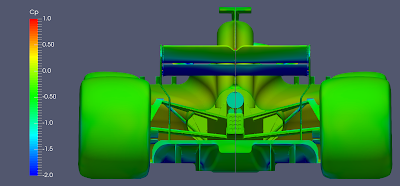1. Overview
I was curious about what halo does in aerodynamics of an F1 car. In this article, I will show the results of CFD simulations of an F1 car, one is without a halo, and the other is with a halo.
2. Halo
The halo was desigined using the following document.
Perrinn F1 V13 was used as the car, which was designed according to the 2017 F1 technical regulations.
3. Simulation Setup
Wind Speed: 50 m/s
Ride Height: 20mm/50mm (Front/Rear)
Solver: foam-extend-3.2 steady-state solver
Turbulence Model: Spalart Allmaras (+Rotation/Curvature Correction)
4. Forces
SCd = Frontal Area × Drag Coefficient
SCl = Frontal Area × Lift Coefficient
L/D = SCl / SCd
FrDF% = Front Downforce / Downforce
SCl_F = Frontal Area × Front Lift Coefficient
SCl_R = Frontal Area × Rear Lift Coefficient
Mass = Mass Flow Rate Passing Through Radiator
Drag was slightly increased (might be within the uncertainty).
Downforce was reduced in the middle section of the car. (As a result, both Front/Rear Downforce were reduced.)
You can see how the wake from the halo affects the aerodynamics of cowling in the following Visualization section.
5. Visualization
Lower: Halo off
Upper: Halo on
Pressure Coefficient Bottom View
Lower: Halo off
Upper: Halo on
Lower: Halo off
Upper: Halo on
Pressure Coefficient X-axis Slices
Left: Halo off
Right: Halo on
Total Pressure Coefficient X-axis Slices
Left: Halo off
Right: Halo on









Comments
Post a Comment